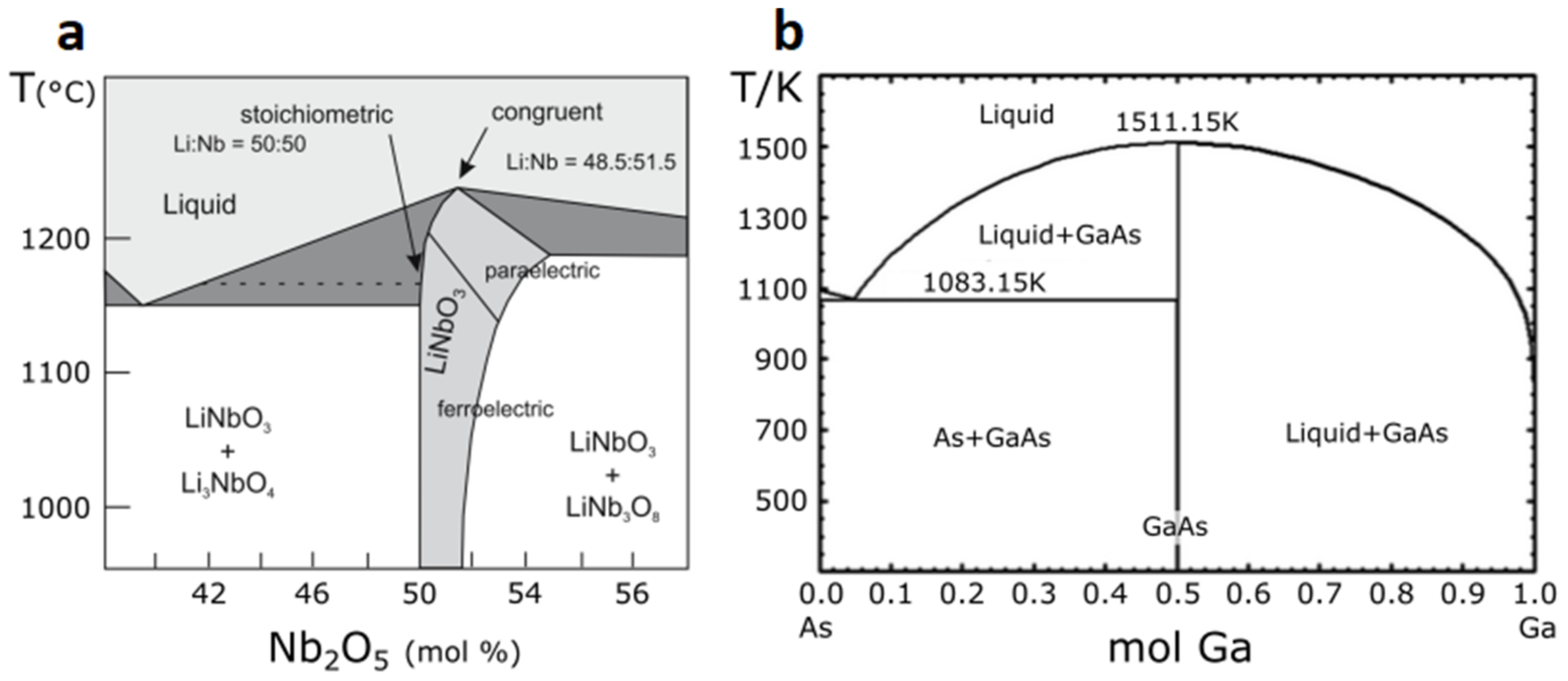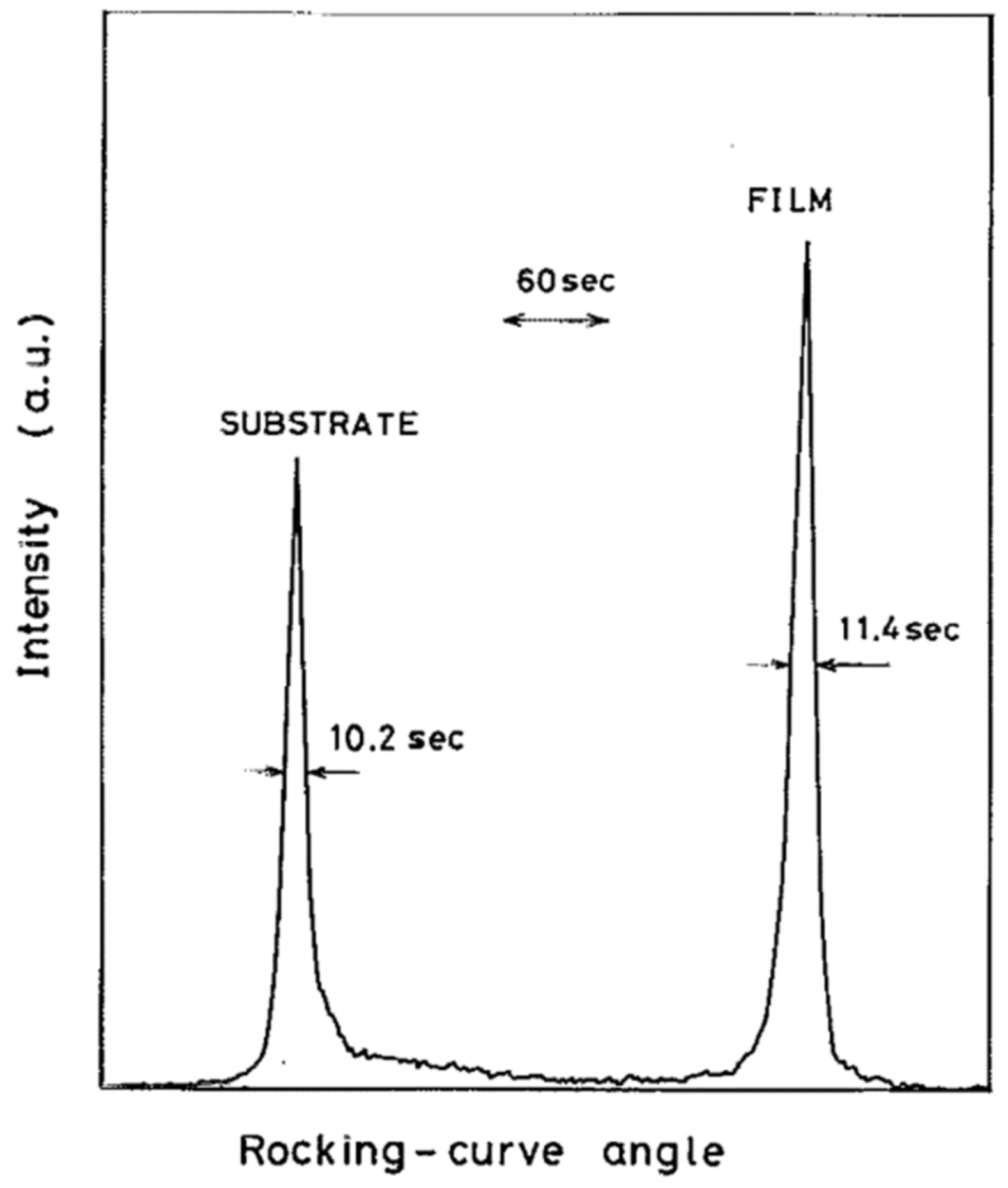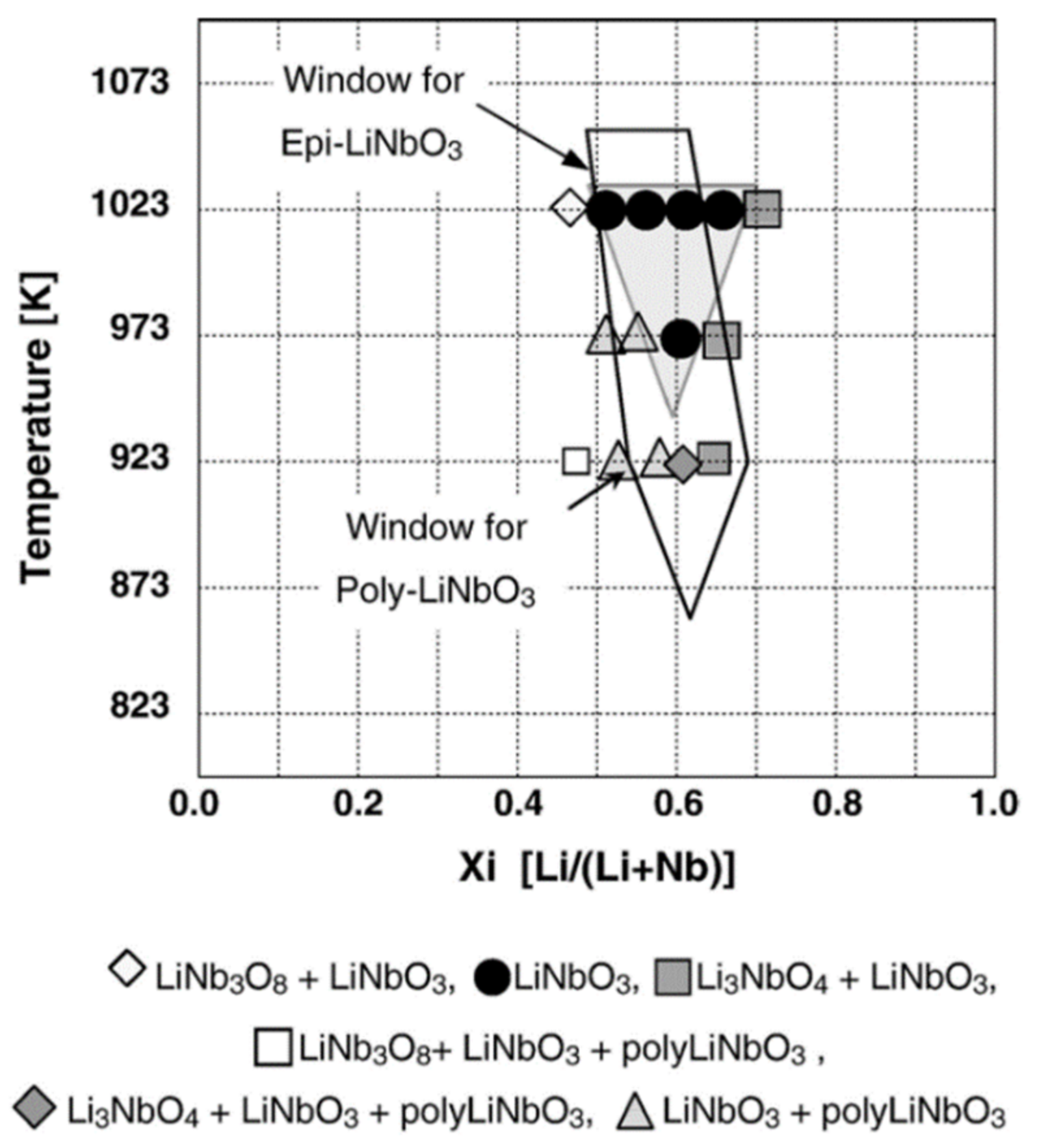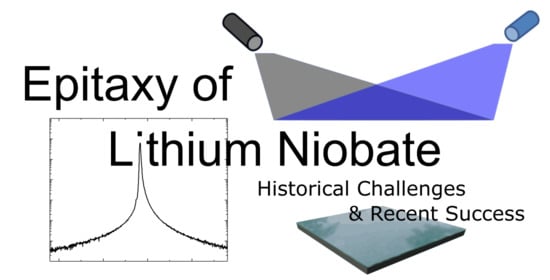Epitaxy of LiNbO3: Historical Challenges and Recent Success
Abstract
1. Introduction
2. The Technical Challenge
3. Liquid Phase Epitaxy (LPE)
4. Sputtering
5. Chemical Vapor Deposition (CVD)
6. Pulsed Laser Deposition (PLD)
7. Molecular Beam Epitaxy (MBE)
8. Conclusions
Author Contributions
Funding
Institutional Review Board Statement
Informed Consent Statement
Acknowledgments
Conflicts of Interest
References
- Weis, R.S.; Gaylord, T.K. Lithium niobate: Summary of physical properties and crystal structure. Appl. Phys. A 1985, 37, 191–203. [Google Scholar] [CrossRef]
- Sugii, K.; Fukuma, M.; Iwasaki, H. A study on titanium diffusion into LiNbO3 waveguides by electron probe analysis and X-ray diffraction methods. J. Mater. Sci. 1978, 13, 523–533. [Google Scholar] [CrossRef]
- Armenise, M.; Canali, C.; De Sario, M.; Carnera, A.; Mazzoldi, P.; Celotti, G. Ti Compound Formation During Ti Diffusion in LiNbO3. IEEE Trans. Compon. Hybrids Manuf. Technol. 1982, 5, 212–216. [Google Scholar] [CrossRef]
- Griffiths, G.; Esdaile, R. Analysis of titanium diffused planar optical waveguides in lithium niobate. IEEE J. Quantum Electron. 1984, 20, 149–159. [Google Scholar] [CrossRef]
- Hall, D.G.; Hutcheson, L.D. Loss Mechanisms in Planar and Channel Waveguides. In Integrated Optical Circuits and Components: Design and Applications; Marcel Dekker: New York, NY, USA, 1987. [Google Scholar]
- White, I.A.; Hutcheson, L.D.; Burke, J.J. Modal Fields and Curvature Losses in Ti-diffused LiNbO3 Waveguides. Guided Wave Opt. Surf. Acoust. Wave Devices Syst. Appl. 1981, 239, 74–80. [Google Scholar] [CrossRef]
- Bruel, M. Silicon on insulator material technology. Electron. Lett. 1995, 31, 1201. [Google Scholar] [CrossRef]
- Thin Films—Partow Technologies. Available online: http://www.partow-tech.com/thinfilms/ (accessed on 5 January 2021).
- Poberaj, G.; Hu, H.; Sohler, W.; Gunter, P. Lithium niobate on insulator (LNOI) for micro-photonic devices. Laser Photon Rev. 2012, 6, 488–503. [Google Scholar] [CrossRef]
- Honardoost, A.; Abdelsalam, K.; Fathpour, S. Rejuvenating a Versatile Photonic Material: Thin-Film Lithium Niobate. Laser Photon Rev. 2020, 14, 2000088. [Google Scholar] [CrossRef]
- Zhang, M.; Wang, C.; Cheng, R.; Shams-Ansari, A.; Lončar, M. Monolithic ultra-high-Q lithium niobate microring resonator. Optica 2017, 4, 1536–1537. [Google Scholar] [CrossRef]
- Zhao, L.; Shi, L.; Wang, J.; Yan, J.; Chen, Y.; Zheng, Y. Effect of doping Mg on the structure and optical properties of LiNbO3 films prepared by radio-frequency magnetron sputtering. Mater. Sci. Semicond. Process. 2020, 108, 104901. [Google Scholar] [CrossRef]
- Li, W.; Cui, J.; Wang, W.; Zheng, D.; Jia, L.; Saeed, S.; Liu, H.; Rupp, R.; Kong, Y.; Xu, J. P-Type Lithium Niobate Thin Films Fabricated by Nitrogen-Doping. Materials 2019, 12, 819. [Google Scholar] [CrossRef]
- Sumets, M.; Ovchinnikov, O.; Ievlev, V.; Kostyuchenko, A. Optical band gap shift in thin LiNbO3 films grown by radio-frequency magnetron sputtering. Ceram. Int. 2017, 43, 13565–13568. [Google Scholar] [CrossRef]
- Ballato, J.; Hawkins, T.; Foy, P.; Yazgan-Kokuoz, B.; McMillen, C.; Burka, L.; Morris, S.; Stolen, R.; Rice, R. Advancements in semiconductor core optical fiber. Opt. Fiber Technol. 2010, 16, 399–408. [Google Scholar] [CrossRef]
- Dauter, Z.; Jaskólski, M. Crystal pathologies in macromolecular crystallography. Postępy Biochem. 2017, 62, 401–407. [Google Scholar]
- Ballman, A.; Brown, H.; Tien, P.; Riva-Sanseverino, S. The growth of solid solution LiNbO3—LiTaO3 thin films for optical waveguides. J. Cryst. Growth 1975, 30, 37–41. [Google Scholar] [CrossRef]
- Ballman, A.; Brown, H.; Tien, P.; Riva-Sanseverino, S. The growth of LiNbO3 thin films by liquid phase epitaxial techniques. J. Cryst. Growth 1975, 29, 289–295. [Google Scholar] [CrossRef]
- Miyazawa, S.; Fushimi, S.; Kondo, S. Optical waveguide of LiNbO3 thin film grown by liquid phase epitaxy. Appl. Phys. Lett. 1975, 26, 8–10. [Google Scholar] [CrossRef]
- Kondo, S.; Miyazawa, S.; Fushimi, S.; Sugii, K. Liquid-phase-epitaxial growth of single-crystal LiNbO3 thin film. Appl. Phys. Lett. 1975, 26, 489–491. [Google Scholar] [CrossRef]
- Baudrant, A.; Vial, H.; Daval, J. Liquid phase epitaxial growth of LiNbO3 thin films. J. Cryst. Growth 1978, 43, 197–203. [Google Scholar] [CrossRef]
- Tamada, H.; Yamada, A.; Saitoh, M. LiNbO3 thin-film optical waveguide grown by liquid phase epitaxy and its application to second-harmonic generation. J. Appl. Phys. 1991, 70, 2536–2541. [Google Scholar] [CrossRef]
- Yamada, A.; Tamada, H.; Saitoh, M. LiNbO3 thin-film optical waveguide grown by liquid phase epitaxy using Li2O-B2O3 flux. Appl. Phys. Lett. 1992, 61, 2848–2850. [Google Scholar] [CrossRef]
- Lu, Y.; Johnston, B.; Dekker, P.; Dawes, J.M. Second Harmonic Generation in Lithium Niobate Planar Waveguides Grown by Liquid Phase Epitaxy. In Proceedings of the Conference on Lasers and Electro-Optics 2009, Baltimore, MD, USA, 31 May–5 June 2009; The Optical Society: Washington, DC, USA, 2009; pp. 1–2. [Google Scholar]
- Lu, Y.; Dekker, P.; Dawes, J.M. Growth and characterization of lithium niobate planar waveguides by liquid phase epitaxy. J. Cryst. Growth 2009, 311, 1441–1445. [Google Scholar] [CrossRef]
- Lu, Y.; Johnston, B.; Dekker, P.; Withford, M.J.; Dawes, J.M. Channel Waveguides in Lithium Niobate and Lithium Tantalate. Molecules 2020, 25, 3925. [Google Scholar] [CrossRef]
- Fukunishi, S.; Kawana, S.; Uchida, N. No Title. In Proceedings of the 9th International Congress on Crystallography, Kyoto, Japan, 26 August–7 September 1972. [Google Scholar]
- Takada, S.; Ohnishi, M.; Hayakawa, H.; Mikoshiba, N. Optical waveguides of single-crystal LiNbO3 film deposited by rf sputtering. Appl. Phys. Lett. 1974, 24, 490–492. [Google Scholar] [CrossRef]
- Jain, K.; Hewig, G. Phase-matched second-harmonic generation at 440 nm in a LiNbO3 -Gd3Ga5O12 waveguide with a tunable stimulated Raman source. Opt. Commun. 1981, 36, 483–486. [Google Scholar] [CrossRef]
- Hewig, G.; Jain, K.; Sequeda, F.; Tom, R.; Wang, P.-W. R.F. Sputtering of LiNbO3 thin films. Thin Solid Film. 1982, 88, 67–74. [Google Scholar] [CrossRef]
- Meek, P.; Holland, L.; Townsend, P. Sputter deposition of LiNbO3 films. Thin Solid Film. 1986, 141, 251–259. [Google Scholar] [CrossRef]
- Kanata, T.; Kobayashi, Y.; Kubota, K. Epitaxial growth of LiNbO3-LiTaO3 thin films on Al2O3. J. Appl. Phys. 1987, 62, 2989–2993. [Google Scholar] [CrossRef]
- Rost, T.A.; Baumann, R.C.; Stone, B.A.; Rabson, T.A. Physical characterization of RF sputtered lithium niobate films. In Proceedings of the 1990 IEEE 7th International Symposium on Applications of Ferroelectrics, Urbana-Champaign, IL, USA, 6–8 June 1990; IEEE: Piscataway, NJ, USA, 2002; pp. 125–128. [Google Scholar]
- Fujimura, N.; Ito, T.; Kakinoki, M. Heteroepitaxy of LiNbO3 and LiNb3O8 thin films on C-cut sapphire. J. Cryst. Growth 1991, 115, 821–825. [Google Scholar] [CrossRef]
- Rost, T.A.; Lin, H.; Rabson, T.A.; Baumann, R.C.; Callahan, D.L. Deposition and analysis of lithium niobate and other lithium niobium oxides by rf magnetron sputtering. J. Appl. Phys. 1992, 72, 4336–4343. [Google Scholar] [CrossRef]
- Shimizu, M.; Furushima, Y.; Nishida, T.; Shiosaki, T. Preparation and Optical Waveguide Properties of LiNbO3 Thin Films by RF Magnetron Sputtering. Jpn. J. Appl. Phys. 1993, 32, 4111–4114. [Google Scholar] [CrossRef]
- Kingston, J.J.; Fork, D.K.; Leplingard, F.; Ponce, F.A. C− Outgrowths in C+ Thin Films of LiNbO3 on Al2O3-c. MRS Online Proc. Libr. Arch. 1994, 341, 289–294. [Google Scholar] [CrossRef]
- Dogheche, E.-H.; Lansiaux, X.; Rémiens, D. Growth and optical waveguiding properties of rf sputtered lithium niobate thin films on sapphire substrates. Integr. Ferroelectr. 1999, 25, 47–59. [Google Scholar] [CrossRef]
- Lansiaux, X.; Dogheche, E.; Remiens, D.; Guilloux-Viry, M.; Perrin, A.; Ruterana, P. LiNbO3 thick films grown on sapphire by using a multistep sputtering process. J. Appl. Phys. 2001, 90, 5274–5277. [Google Scholar] [CrossRef]
- Sumets, M.; Dybov, V.; Serikov, D.; Belonogov, E.; Seredin, P.; Goloshchapov, D.; Grebennikov, A.; Ievlev, V. Effect of reactive gas composition on properties of Si/LiNbO3 heterojunctions grown by radio-frequency magnetron sputtering. J. Sci. Adv. Mater. Devices 2020, 5, 512–519. [Google Scholar] [CrossRef]
- Cowher, M.E.; Sedgwick, T.O.; Landermann, J. Epitaxial garnet films by organometallic chemical vapor deposition. J. Electron. Mater. 1974, 3, 621–633. [Google Scholar] [CrossRef]
- Curtis, B.; Brunner, H. The growth of thin films of lithium niobate by chemical vapour de position. Mater. Res. Bull. 1975, 10, 515–520. [Google Scholar] [CrossRef]
- Wernberg, A.A.; Gysling, H.J.; Filo, A.J.; Blanton, T.N. Epitaxial growth of lithium niobate thin films from a single-source organometallic precursor using metalorganic chemical vapor deposition. Appl. Phys. Lett. 1993, 62, 946–948. [Google Scholar] [CrossRef]
- Wernberg, A.A.; Gysling, H.J. MOCVD deposition of epitaxial lithium niobate, LiNbO3, thin films using the single source precursor lithium niobium ethoxide, LiNb(OEt)6. Chem. Mater. 1993, 5, 1056–1058. [Google Scholar] [CrossRef]
- Lu, Z.; Hiskes, R.; DiCarolis, S.; Route, R.; Feigelson, R.; Leplingard, F.; Fouquet, J. Epitaxial LiNbO3 thin films on sapphire substrates grown by solid source MOCVD. J. Mater. Res. 1994, 9, 2258–2263. [Google Scholar] [CrossRef]
- Feigelson, R. Epitaxial growth of lithium niobate thin films by the solid source MOCVD method. J. Cryst. Growth 1996, 166, 1–16. [Google Scholar] [CrossRef]
- Lee, S.; Feigelson, R. Reduced optical losses in MOCVD grown lithium niobate thin films on sapphire by controlling nucleation density. J. Cryst. Growth 1998, 186, 594–606. [Google Scholar] [CrossRef]
- Saulys, D.; Joshkin, V.; Khoudiakov, M.; Kuech, T.; Ellis, A.; Oktyabrsky, S.; McCaughan, L. An examination of the surface decomposition chemistry of lithium niobate precursors under high vacuum conditions. J. Cryst. Growth 2000, 217, 287–301. [Google Scholar] [CrossRef]
- Akiyama, Y.; Shitanaka, K.; Murakami, H.; Shin, Y.-S.; Yoshida, M.; Imaishi, N. Epitaxial growth of lithium niobate film using metalorganic chemical vapor deposition. Thin Solid Film. 2007, 515, 4975–4979. [Google Scholar] [CrossRef]
- Margueron, S.; Bartasyte, A.; Plausinaitiene, V.; Abrutis, A.; Boulet, P.; Kubilius, V.; Saltyte, Z. Effect of deposition conditions on the stoichiometry and structural properties of LiNbO3 thin films deposited by MOCVD. In Oxide-based Materials and Devices IV; International Society for Optics and Photonics: Bellingham, WA, USA, 2013; Volume 8626, p. 862612. [Google Scholar]
- Ogale, S.B.; Nawathey-Dikshit, R.; Dikshit, S.J.; Kanetkar, S.M. Pulsed laser deposition of stoichiometric LiNbO3 thin films by using O2 and Ar gas mixtures as ambients. J. Appl. Phys. 1992, 71, 5718–5720. [Google Scholar] [CrossRef]
- Shibata, Y.; Kaya, K.; Akashi, K.; Kanai, M.; Kawai, T.; Kawai, S. Epitaxial growth of LiNbO3 thin films by excimer laser ablation method and their surface acoustic wave properties. Appl. Phys. Lett. 1992, 61, 1000–1002. [Google Scholar] [CrossRef]
- Fork, D.K.; Anderson, G.B. Epitaxial MgO on GaAs(111) as a buffer layer for z-cut epitaxial lithium niobate. Appl. Phys. Lett. 1993, 63, 1029–1031. [Google Scholar] [CrossRef]
- Marsh, A.M.; Harkness, S.D.; Qian, F.; Singh, R.K. Pulsed laser deposition of high quality LiNbO3 films on sapphire substrates. Appl. Phys. Lett. 1993, 62, 952–954. [Google Scholar] [CrossRef]
- Aubert, P.; Garry, G.; Bisaro, R.; López, J.G. Structural properties of LiNbO3 thin films grown by the pulsed laser deposition technique. Appl. Surf. Sci. 1995, 86, 144–148. [Google Scholar] [CrossRef]
- Shibata, Y.; Kaya, K.; Akashi, K.; Kanai, M.; Kawai, T.; Kawai, S. Epitaxial growth and surface acoustic wave properties of lithium niobate films grown by pulsed laser deposition. J. Appl. Phys. 1995, 77, 1498–1503. [Google Scholar] [CrossRef]
- Afonso, C.N.; Gonzalo, J.; Vega, F.; Dieguez, E.; Cheang Wong, J.C.; Ortega, C.; Siejka, J.; Amsel, G. Correlation between optical properties, composition, and deposition parameters in pulsed laser deposited LiNbO3 films. Appl. Phys. Lett. 1995, 66, 1452–1454. [Google Scholar] [CrossRef]
- Lee, S.-H.; Song, T.K.; Noh, T.W.; Lee, J.-H. Low-temperature growth of epitaxial LiNbO3 films on sapphire (0001) substrates using pulsed laser deposition. Appl. Phys. Lett. 1995, 67, 43–45. [Google Scholar] [CrossRef]
- Aubert, P.; Garry, G.; Bisaro, R.; Olivier, J.; López, J.G.; Urlacher, C. Epitaxial growth of LiNbO3 thin films on (001) sapphire by Pulsed Laser Deposition. Microelectron. Eng. 1995, 29, 107–110. [Google Scholar] [CrossRef]
- Veignant, F.; Gandais, M.; Aubert, P.; Garry, G. Structural evolution of lithium niobate deposited on sapphire (0001): From early islands to continuous films. J. Cryst. Growth 1999, 196, 141–150. [Google Scholar] [CrossRef]
- Kakehi, Y.; Okamoto, A.; Sakurai, Y.; Nishikawa, Y.; Yotsuya, T.; Ogawa, S. Epitaxial growth of LiNbO3 thin films using pulsed laser deposition. Appl. Surf. Sci. 2001, 169–170, 560–563. [Google Scholar] [CrossRef]
- Son, J.-W.; Orlov, S.S.; Phillips, B.; Hesselink, L. Pulsed laser deposition of single phase LiNbO3 thin film waveguides. J. Electroceram. 2006, 17, 591–595. [Google Scholar] [CrossRef]
- Kilburger, S.; Chety, R.; Millon, E.; Di Bin, P.; Di Bin, C.; Boulle, A.; Guinebretière, R. Growth of LiNbO3 thin films on sapphire by pulsed-laser deposition for electro-optic modulators. Appl. Surf. Sci. 2007, 253, 8263–8267. [Google Scholar] [CrossRef]
- Kilburger, S.; Millon, E.; Di Bin, P.; Boulle, A.; Guinebretière, R.; Di Bin, C. Properties of LiNbO3 based heterostructures grown by pulsed-laser deposition for optical waveguiding application. Thin Solid Film. 2010, 518, 4654–4657. [Google Scholar] [CrossRef]
- Paldi, R.L.; Qi, Z.; Misra, S.; Lu, J.; Sun, X.; Phuah, X.L.; Kalaswad, M.; Bischoff, J.; Branch, D.W.; Siddiqui, A.; et al. Nanocomposite-Seeded Epitaxial Growth of Single-Domain Lithium Niobate Thin Films for Surface Acoustic Wave Devices. Adv. Photon Res. 2021, 2000149. [Google Scholar] [CrossRef]
- Betts, R.; Pitt, C. Growth of thin-film lithium niobate by molecular beam epitaxy. Electron. Lett. 1985, 21, 960–962. [Google Scholar] [CrossRef]
- Petrucci, M.; Pitt, C. Reflection high-energy electron diffraction from lithium niobate single-crystal surfaces for application in molecular beam epitaxy. Electron. Lett. 1986, 22, 637. [Google Scholar] [CrossRef]
- Petrucci, M.; Pitt, C.W.; Reynolds, S.R.; Milledge, H.J.; Mendelssohn, M.J.; Dineen, C.; Freeman, W.G. Growth of thin-film niobium and niobium oxide layers by molecular-beam epitaxy. J. Appl. Phys. 1988, 63, 900–909. [Google Scholar] [CrossRef]
- Sitar, Z.; Gitmans, F.; Liu, W.; Günter, P. Homo and Heteroepitaxial Growth of LiTaO3 and LiNbO3 by Mbe. MRS Online Proc. Libr. Arch. 1995, 401, 255–260. [Google Scholar] [CrossRef]
- Matsubara, K.; Niki, S.; Watanabe, M.; Fons, P.; Iwata, K.; Yamada, A. Growth of LiNbO3 epitaxial films by oxygen radical-assisted laser molecular beam epitaxy. Appl. Phys. A 1999, 69, S679–S681. [Google Scholar] [CrossRef]
- Doolittle, W.A.; Carver, A.G.; Henderson, W. Molecular beam epitaxy of complex metal-oxides: Where have we come, where are we going, and how are we going to get there? J. Vac. Sci. Technol. B Microelectron. Nanometer Struct. Process. Meas. Phenom. 2005, 23, 1272. [Google Scholar] [CrossRef]
- Doolittle, W.; Carver, A.; Henderson, W.; Calley, W. Molecular Beam Epitaxy of Lithium Niobate Multifunctional Materials Using a Chloride Refractory Metal Chemistry. ECS Trans. 2006, 2, 103–114. [Google Scholar] [CrossRef]
- Dabirian, A.; Harada, S.; Kuzminykh, Y.; Sandu, S.C.; Wagner, E.; Benvenuti, G.; Brodard, P.; Rushworth, S.; Muralt, P.; Hoffmann, P. Combinatorial Chemical Beam Epitaxy of Lithium Niobate Thin Films on Sapphire. J. Electrochem. Soc. 2011, 158, D72–D76. [Google Scholar] [CrossRef]
- Henderson, W.E.; Calley, W.L.; Carver, A.G.; Chen, H.; Doolittle, W.A. A versatile metal-halide vapor chemistry for the epitaxial growth of metallic, insulating and semiconducting films. J. Cryst. Growth 2011, 324, 134–141. [Google Scholar] [CrossRef]
- Greenlee, J.D.; Calley, W.L.; Henderson, W.; Doolittle, W.A. Halide based MBE of crystalline metals and oxides. Phys. Status Solidi C 2011, 9, 155–160. [Google Scholar] [CrossRef]
- Tellekamp, M.B.; Greenlee, J.D.; Shank, J.C.; Doolittle, W.A. Molecular beam epitaxy growth of niobium oxides by solid/liquid state oxygen source and lithium assisted metal-halide chemistry. J. Cryst. Growth 2015, 425, 225–229. [Google Scholar] [CrossRef]
- Tellekamp, M.B.; Shank, J.C.; Goorsky, M.S.; Doolittle, W.A. Molecular Beam Epitaxy Growth of High Crystalline Quality LiNbO3. J. Electron. Mater. 2016, 45, 6292–6299. [Google Scholar] [CrossRef]
- Volk, T.; Wöhlecke, M. Lithium Niobate: Defects, Photorefraction and Ferroelectric Switching; Springer: Berlin/Heidelberg, Germany, 2008; Volume 115. [Google Scholar]
- Liu, D.; Zha, G.; Hu, L.; Jiang, W. Recovery of Gallium and Arsenic from Gallium Arsenide Semiconductor Scraps. In TMS Annual Meeting & Exhibition; Springer: Berlin/Heidelberg, Germany, 2018; pp. 319–330. [Google Scholar]
- Tellekamp, M.B.; Shank, J.C.; Doolittle, W.A. Molecular Beam Epitaxy of lithium niobium oxide multifunctional materials. J. Cryst. Growth 2017, 463, 156–161. [Google Scholar] [CrossRef]
- Zivasatienraj, B.; Tellekamp, M.B.; Weidenbach, A.S.; Ghosh, A.; McCrone, T.M.; Doolittle, W.A. Temporal versatility from intercalation-based neuromorphic devices exhibiting 150 mV non-volatile operation. J. Appl. Phys. 2020, 127, 084501. [Google Scholar] [CrossRef]
- Miyazawa, S. Growth of LiNbO3single-crystal film for optical waveguides. Appl. Phys. Lett. 1973, 23, 198–200. [Google Scholar] [CrossRef]
- Bartasyte, A.; Plausinaitiene, V.; Abrutis, A.; Stanionyte, S.; Margueron, S.; Boulet, P.; Kobata, T.; Uesu, Y.; Gleize, J. Identification of LiNbO3, LiNb3O8 and Li3NbO4 phases in thin films synthesized with different deposition techniques by means of XRD and Raman spectroscopy. J. Phys. Condens. Matter 2013, 25, 205901. [Google Scholar] [CrossRef]
- Astié, V.; Oliveri, S.; Millon, C.; Margueron, S.; Rachetti, M.; Decams, J.; Boulet, P.; Bartasyte, A. Towards stoichiometric LiNbO3 epitaxial thin films grown by DLI-MOCVD. In Proceedings of the GDR Oxydes Fonctionnels—des Matériaux Aux Dispositifs, Piriac sur Mer, France, 20–23 March 2018. [Google Scholar]
- Cho, A.Y. Morphology of Epitaxial Growth of GaAs by a Molecular Beam Method: The Observation of Surface Structures. J. Appl. Phys. 1970, 41, 2780–2786. [Google Scholar] [CrossRef]
- Cho, A.Y.; Panish, M.B.; Hayashi, I. Molecular beam epitaxy of GaAs, AlxGa1-xAs and GaP. Proc. Symp. GaAs Relat. Compd. 1970, 2, 18–29. [Google Scholar]





| Epitaxial Technique | Optical Loss (dB/cm) | XRD FWHM (Arcseconds) | Notes | Reference |
|---|---|---|---|---|
| LPE | 5 | - | 20–30 dB/cm losses at visible wavelengths. | Kondo et al. [20] |
| <5 | - | - | Ballman et al. [18] | |
| 1.6 | 11 | Significant vanadium impurities. λ = 514.5 nm. | Tamada et al. [22] | |
| <1 | 11.4 | λ = 458 nm. | Yamada et al. [23] | |
| Sputter | 9 | - | - | Takada et al. [28] |
| 3 | - | Amorphous film. | Hewig et al. [30] | |
| 6.47 | - | - | Shimizu et al. [36] | |
| 1.2 | 648 | Multi-step process. | Lansiaux et al. [39] | |
| CVD | - | 1368 | Twinning detected. | Wernberg et al. [44] |
| 1.8 | 36 | No twinning detected. | Feigelson et al. [46] | |
| PLD | - | 612 | - | Shibata et al. [56] |
| - | 360 | - | Aubert et al. [59] | |
| <1.5 | 165.6 | - | Kilburger et al. [64] | |
| MBE | 15.7 | - | Electron-beam evaporated sources. | Betts and Pitt [66] |
| - | 13 | Twinning detected. Laser assisted. | Matsubara et al. [70] | |
| - | 104 | Metal–organic precursors. | Dabirian et al. [73] | |
| - | 8.6 | No twinning detected. Metal–halide sources. | Tellekamp et al. [77] |
Publisher’s Note: MDPI stays neutral with regard to jurisdictional claims in published maps and institutional affiliations. |
© 2021 by the authors. Licensee MDPI, Basel, Switzerland. This article is an open access article distributed under the terms and conditions of the Creative Commons Attribution (CC BY) license (https://creativecommons.org/licenses/by/4.0/).
Share and Cite
Zivasatienraj, B.; Tellekamp, M.B.; Doolittle, W.A. Epitaxy of LiNbO3: Historical Challenges and Recent Success. Crystals 2021, 11, 397. https://doi.org/10.3390/cryst11040397
Zivasatienraj B, Tellekamp MB, Doolittle WA. Epitaxy of LiNbO3: Historical Challenges and Recent Success. Crystals. 2021; 11(4):397. https://doi.org/10.3390/cryst11040397
Chicago/Turabian StyleZivasatienraj, Bill, M. Brooks Tellekamp, and W. Alan Doolittle. 2021. "Epitaxy of LiNbO3: Historical Challenges and Recent Success" Crystals 11, no. 4: 397. https://doi.org/10.3390/cryst11040397
APA StyleZivasatienraj, B., Tellekamp, M. B., & Doolittle, W. A. (2021). Epitaxy of LiNbO3: Historical Challenges and Recent Success. Crystals, 11(4), 397. https://doi.org/10.3390/cryst11040397








